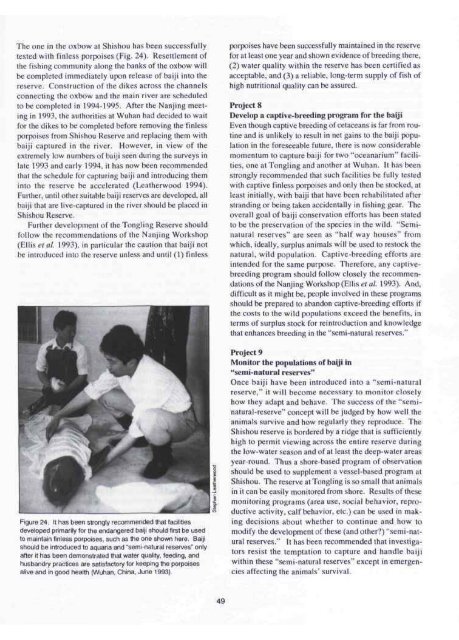Dolphins, Porpoises, and Whales - IUCN
Dolphins, Porpoises, and Whales - IUCN
Dolphins, Porpoises, and Whales - IUCN
You also want an ePaper? Increase the reach of your titles
YUMPU automatically turns print PDFs into web optimized ePapers that Google loves.
The one in the oxbow at Shishou has been successfully<br />
tested with finless porpoises (Fig. 24). Resettlement of<br />
the fishing community along the banks of the oxbow will<br />
be completed immediately upon release of baiji into the<br />
reserve. Construction of the dikes across the channels<br />
connecting the oxbow <strong>and</strong> the main river are scheduled<br />
to be completed in 1994-1995. After the Nanjing meeting<br />
in 1993, the authorities at Wuhan had decided to wait<br />
for the dikes to be completed before removing the finless<br />
porpoises from Shishou Reserve <strong>and</strong> replacing them with<br />
baiji captured in the river. However, in view of the<br />
extremely low numbers of baiji seen during the surveys in<br />
late 1993 <strong>and</strong> early 1994, it has now been recommended<br />
that the schedule for capturing baiji <strong>and</strong> introducing them<br />
into the reserve be accelerated (Leatherwood 1994).<br />
Further, until other suitable baiji reserves are developed, all<br />
baiji that are live-captured in the river should be placed in<br />
Shishou Reserve.<br />
Further development of the Tongling Reserve should<br />
follow the recommendations of the Nanjing Workshop<br />
(Ellis et al. 1993), in particular the caution that baiji not<br />
be introduced into the reserve unless <strong>and</strong> until (1) finless<br />
Figure 24. It has been strongly recommended that facilities<br />
developed primarily for the endangered baiji should first be used<br />
to maintain finless porpoises, such as the one shown here. Baiji<br />
should be introduced to aquaria <strong>and</strong> "semi-natural reserves" only<br />
after it has been demonstrated that water quality, feeding, <strong>and</strong><br />
husb<strong>and</strong>ry practices are satisfactory for keeping the porpoises<br />
alive <strong>and</strong> In good health (Wuhan, China, June 1993).<br />
49<br />
pxarpoises have been successfully maintained in the reserve<br />
for at least one year <strong>and</strong> shown evidence of breeding there,<br />
(2) water quality within the reserve has been certified as<br />
acceptable, <strong>and</strong> (3) a reliable, long-term supply of fish of<br />
high nutritional quality can be assured.<br />
Project 8<br />
Develop a captive-breeding program for the baiji<br />
Even though captive breeding of cetaceans is far from routine<br />
<strong>and</strong> is unlikely to result in net gains to the baiji population<br />
in the foreseeable future, there is now considerable<br />
momentum to capture baiji for two "oceanarium" facilities,<br />
one at Tongling <strong>and</strong> another at Wuhan. It has been<br />
strongly recommended that such facilities be fully tested<br />
with captive finless porpoises <strong>and</strong> only then be stocked, at<br />
least initially, with baiji that have been rehabilitated after<br />
str<strong>and</strong>ing or being taken accidentally in fishing gear. The<br />
overall goal of baiji conservation efforts has been stated<br />
to be the preservation of the species in the wild. "Seminatural<br />
reserves" are seen as "half way houses" from<br />
which, ideally, surplus animals will be used to restock the<br />
natural, wild population. Captive-breeding efforts are<br />
intended for the same purpose. Therefore, any captivebreeding<br />
program should follow closely the recommendations<br />
of the Nanjing Workshop (Ellis era/. 1993). And,<br />
difficult as it might be, people involved in these programs<br />
should be prepared to ab<strong>and</strong>on captive-breeding efforts if<br />
the costs to the wild populations exceed the benefits, in<br />
terms of surplus stock for reintroduction <strong>and</strong> knowledge<br />
that enhances breeding in the "semi-natural reserves."<br />
Project 9<br />
Monitor the populations of baiji in<br />
"semi-natural reserves"<br />
Once baiji have been introduced into a "semi-natural<br />
reserve," it will become necessary to monitor closely<br />
how they adapt <strong>and</strong> behave. The success of the "seminatural-reserve"<br />
concept will be judged by how well the<br />
animals survive <strong>and</strong> how regularly they reproduce. The<br />
Shishou reserve is bordered by a ridge that is sufficiently<br />
high to permit viewing across the entire reserve during<br />
the low-water season <strong>and</strong> of at least the deep-water areas<br />
year-round. Thus a shore-based program of observation<br />
should be used to supplement a vessel-based program at<br />
Shishou. The reserve at Tongling is so small that animals<br />
in it can be easily monitored from shore. Results of these<br />
monitoring programs (area use, social behavior, reproductive<br />
activity, calf behavior, etc.) can be used in making<br />
decisions about whether to continue <strong>and</strong> how to<br />
modify the development of these (<strong>and</strong> other?) "semi-natural<br />
reserves." It has been recommended that investigators<br />
resist the temptation to capture <strong>and</strong> h<strong>and</strong>le baiji<br />
within these "semi-natural reserves" except in emergencies<br />
affecting the animals' survival.

















